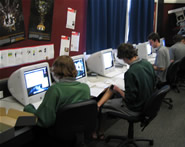Delivery

Four one-hour periods were available each week to deliver the course. The course was practically-based with one major web-related project. The major unit had a number of parts and involved a wide range of skills:
- Term 1 : Introduction to xhtml, css and revision of website design and creation. Introduction to animation using Flash and to programming using ActionScript.
- Term 2 : Develop the brief for an outcome to a communication issue for a group (such as a sports team, school band, etc). Start developing the outcome.
- Term 3: Create a high quality outcome to address or resolve the issue.
- Term 4: Finish off all internally assessed resubmissions and prepare the portfolio for external assessment.
By way of a context for the unit, students were asked to develop a web-based solution for a business, an organisation or a club that communicated appropriately to its target audience. The solution need not be a website – it could, for example, be a Flash movie for an existing website. In Year 10 the class had created a web page using the web-authoring software Dreamweaver ; in the Year 11 unit they would learn the actual coding of web pages, including using CSS and XHTML. Students were introduced to computer programming using the ActionScript programming language and web animation using Flash. Steve introduced the Nature of Technology strand by having students critically examine the web and the way people use it to communicate.Term 1 began with five weeks of skill development. Students created a simple website using XHTML and CSS.
Topics covered included:
- Background on how the web developed, with an emphasis on separating style from content and what this means
- How to create a web page with a text editor with separate content and style
- How to use and style basic selectors
- How to create and style text, lists, links, images, background images
- How to lay out web pages using '<Divs>'
- How to place elements on a page by altering their borders, margins and padding properties.
Initially three weeks were allowed for this, but in fact it took five weeks.
In week four of the first term, students received their major web project. Students were required to decide on their own specific context for their work.
The remainder of the term was spent learning how to create animations for the web using Flash and how to place these animations on a web page using a text editor; learning how to design web pages following good design principles; and learning how to manipulate and optimise images in Photoshop for use on web pages. Students were reminded about the principles of typography and design they had covered the previous year. Steve had the students use visual diaries to capture their ideas.
Term two began with a shift in focus back to Technological Practice. Students revised and extended their Year 10 understandings, then went on to spend most of the term developing briefs for their projects. They researched their chosen issue and their stakeholders. They identified key factors; researched needs and opportunities; and researched for ideas. Project concepts were developed and refined in consultation with stakeholders. Initial briefs were written and, after research into the ethics and codes of practice followed by professional web designers and the pertinent legal considerations, refined. Some initial assessment of brief development occurred at the end of term 2 checkpoint. Steve conferred with the students one-on-one at this stage to check progress and provide students with formative feedback.
Term 3 started with a small (2-3 week) unit on how to use the programming language (ActionScript) to produce interactive animations for web pages. This upskilling hadn't originally been planned for but it was felt it was needed to break up the project work. The remainder of the term and two weeks of term 4 were spent developing and evaluating outcomes. Students planned their workloads and further developed their ideas with stakeholders into complete working websites. The last four weeks of the fourth term were spent resubmitting for internals and preparing externals for assessment.
Assessment

Rather than taking an 'either/or' approach, Steve used a mixture of technology achievement standards and ICT unit standards for assessment. The course was assessed using Level 1 achievement standards and one Level 2 unit standard:
- AS 1.1 (90045v2): Develop a technological solution to address a given brief (6 credits, Internal)
- AS 1.2 (90046v2): Formulate a brief to address a given issue (6 credits, Internal)
- AS 1.5 (90049v2): Demonstrate understanding of technological knowledge (4 credits, External)
- AS 1.6 (90050v3): Present a technological solution that addresses the requirements of a brief (4 credits, Internal)
- AS 1.7 (90051v2): Demonstrate understanding of interactions between a technological innovation and society (4 credits, External)
- US18736v2: Create a simple website using a text editor to meet the specifications of a given brief (4 credits, Internal)
A total 28 credits were achievable; however, most students submitted for 20 -24 credits.
For each standard there was one formal assessment and one further resubmission opportunity. The key evidence for the externals was submitted as a written report/portfolio (either on a CD or on paper or as a combination of the two) along with a visual diary. Students were required to sign an authenticity sheet for all assessments to verify the work was their own.
The unit embraced the alternative ways identified by the Beacon cluster to gather and present assessment evidence using the technology available in an IT classroom. Alternative Assessment Schedules had been developed and since updated. Also, instead of using folios exclusively to document their work, students were encouraged to use methods such as screen shots, digital photos, audio clips and digital videos.
The aim of using the Alternative Assessment Schedules was to help students better understand the assessment criteria and what assessment evidence they should be gathering. By so doing it was hoped student practice would be project-driven rather than assessment-driven. In the best-possible case, the assessment requirements would naturally 'fall out' of the process.
At each of several one-on-one teacher/student conferences, students were questioned about their practice and development of their outcome; the aim was to have students understand exactly what was required of them and have them gather enough of the right kind of assessment information.
Students provided with checklists to ensure they covered all the assessment bases. This approach worked well, says Steve. The students also received formal 'checkpoints' through the year at which they had to submit work for assessment.
